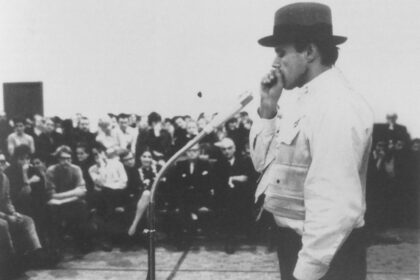Book Review: Jacopo Galimberti, Individuals against Individualism. Art Collectives in Western Europe (1956-1969), (Liverpool: Liverpool University Press, 2017)
Carlos Garrido Castellano
Jacopo Galimberti’s Individuals against Individualism. Art Collectives in Western Europe (1956-1969) is a solid piece of art historical scholarship dealing with a still neglected area of research, that of the artistic collectives that paved the way for the emergence of activist and socially-engaged art initiatives from the 1970s onward. Registering the transnational flows and aesthetic experiments of a handful of groups (including Spur, N, Equipo 57, Equipo Crónica, the International Situationist, GRAV, Komunne I), the book is composed of four chapters discussing several artistic projects, socio-historical background, critical discussions and institutional politics. The in-depth examination of these initiatives, many of which lack significant scholarly attention in English, constitutes one of the book’s three main objectives, the others being to insert these projects under a mobile, transnational framework and to locate a persistent trend of political action within the European avant-garde of the 1950s and 1960s.
Although located in that specific spatial-temporal framework, the book has been conceptualized with the emergence of a major interest in social practice in mind, thus establishing a dialogue with the thought of Greg Sholette, Eve Boltanski and Luc Chiapello and Toni Negri. Individuals against Individualism, in any case, is more committed to developing an exhaustive art-historical approach to a specific epoch than to expanding the potentialities arising out of that epoch within the present. The continuities and connections with former and (then) future forms of art collectivism occupy a second place in favor of a detailed exercise of contextualization and follow-up analysis of the social dimension of the abovementioned artistic projects. This decision grants coherence to the work, although a bit more of speculative thought would have helped in reinforcing the significance of these projects and justifying the author’s interest in exploring them at this moment. Another element that could have been given more attention is the incorporation of anticolonial and antiimperialist struggles within the same cities to which the author pays attention. In this sense, although the influence of big events such as the Cuban Revolution, the Vietnam War and the influence of Maoism is brought into the discussion, the pivotal role of Western European metropolises in the articulation of anticolonial solidarities remains outside of the book’s scope. This is a totally justifiable decision. However, a deeper exploration of these non-European processes would help bringing more nuances to the analysis of the different ways of politicization and social engagement at play in the examined collectives.
Along with the attention paid to the details with which the evolution of the collectives is told, Galimberti’s book also succeeds in giving account of the hesitations and negotiations that many of the artists of these generations faced in order to best conceive their belonging to art groups. Individuals against Individualism is full of well-documented anecdotes focusing on the strategies artists implemented to gain political and social significance and to avoid being captured by art institutions. The relation between collectives and institutional art systems appears here as a complex one, prefiguring the strategies and movements that will characterize art activism and community art groups from the 1970s onwards. Delving into the prehistory of these maneuvers, Galimberti sketches a landscape with no established itinerary: Declaring themselves as part of a group or rejecting any collective categorization; exhibiting or stopping showing altogether; establishing alliances and partnerships or remaining autonomous: all these were paths followed by some of the collectives analyzed in this book, all of them tending towards the same objective. Individual against Individualism does a great job in registering such movements, something that tends to be obliterated in favor of artwork or project-based examinations. More than that, the book goes a step further in tracking the hesitations and discussions leading to the production of artworks, therefore placing emphasis on the diversity of voices and points of views existing within each collective experience. This aspect constitutes one of the most important accomplishments of the book.
Many of the initiatives discussed here are framed as a result of the need to find a third way of political engagement within a Cold War framework in which Communism constituted an increasingly closed framework, whilst the value? of key social values was being refashioned and redefined by Western liberalism. “Collective art practice,” the author affirms, “not only criticised the prevailing figure of the artist, but also redefined the notion of the individual, presenting a model of communality, and ultimately society, that opposed both the Socialist Bloc and the Free World.” (169). In that sense, the historical rigor applied to the analysis of each collective is complemented by choosing a transnational point of analysis. Galimberti highlights the expansive, contaminating capacity of art collectives, which was driven by a direct awareness of the political situation of the epoch. The evolution of the Situationist International and the Spanish Equipo57, for example, is framed under the lens of the Hungarian Revolution of 1956 and the subsequent USSR intervention. Similarly, the trajectories of GRAV and N are framed outside Paris and Padua respectively and in turn inserted within a detailed analysis of the geopolitics of the early 1960s. The acknowledgement of an international dimension for these collectives is essential in disclosing the network of solidarities and the concern for politics and social justice behind many of the initiatives of the moment. Furthermore, the author takes pains to register the multiple strategies used by art collectives in order to eschew the pressures of official institutions and the art market. These strategies reveal a landscape where no single answer ensured the achievement of social transformation and political radicality. Individual against Individualism is about the hesitations and experiments a group of individuals and collectives undertook to confront the social apathy and conservatism of their epoch. This is evident, for example, in the heterogeneous strategies adopted to counter individualism, but also in the occupation of art institutions or in the refusal to exhibit or the support of fellow collectives. The fluidity of these strategies also permeated the slippery attitude of critics and curators, willing to “join the collective cause” while also afraid of their most profound consequences.
This is particularly evident in Chapter 1, which is concerned with the impact of the Hungarian Revolution of 1956 in Western European collectives. The work of Spur, Equipo 57 and the Situationist International are examined here. Galimberti reveals how issues of authorship, group management and personality were already at play at this early stage. Many of the collectives analyzed in this chapter shared a concern for playing a democratizing role within post-war societies, rejecting both aesthetic stagnation and the threats brought into play by liberalism. The objective of the three collectives was to fuse art and life while preserving the revolutionary potential of praxis in the present. In all the cases, collectivism emerges against the view that made single authorship synonymous with artistry. (26) The chapter delves into Debord’s attempts to ensure an anti-capitalist logic within the SI, on Pinot Gallizio’s extravagances and his expulsion, on collective installations and on SPUR’s troubled revival of individualism and conflictive relation with the SI. Concerning Spur, Galimberti argues that “the need to visualise a way out of the dichotomy between the masses and the individual would inform a substantial amount of Spur’s painting and intellectual production.” (45) At this stage, engaging the masses was still seen as problematic, due to the proximity of the Nazi past, something that conditioned Spur’s decisions. A similarly restricted field was the scenario of Equipo 57’s work. In this case, the collective had to face Francoism’s evolution within the Cold War context, a context where collectivism was antithetical to both the fierce individualism and anti-communism advocated by the dictatorship. Despite all the pressure, Equipo 57 adopted a political tone, turning their rejection of informel into an oppositional measure due to Francoism’s sympathy for that trend while also “seeking to realise a radical form of democracy.” (87)
The sociopolitical background of Chapter 2 spans the decisive first half of the 1960s, focusing on GRAV in Paris and N in Padova. In this case, Galimberti reclaims a political side of Post-War avant-garde. When dealing with GRAV, for example, he examines “how the curators obscured the specific ways in which artists voiced social concerns” (102), highlighting an element that sometimes remains unexplored. The combination of an analysis balancing the artistic decisions of both collectives at a time when collectivism was meeting critical success with the political evolution of Gaullism in France and the Operaism in Italy, cement one of the most accomplished sections of the book. Chapter 3 deals with figurative painting in the context of 1960s France. Taking the Parisian Salon de la Jeune Peinture (Young Painting Salon) as unifying thread, it discusses how this institution was changed through the collective action of a group of artists including Eduardo Arroyo, Henri Cueco, Michel Parré or Gérard Tisserand. These artists were interested in updating the display structure of the Salon . Working collectively and adopting a political tone were indispensable to achieving that goal. The chapter covers the discussions with critics, curators and cultural organizers such as Giulio Carlo Argan and the artistic responses to Duchamp’s success. This is the only case, furthermore, when the book covers the production of Western European collectives outside the region, focusing on the collective wall painting Cuba Colectiva produced in Havana in 1967.
The social aspirations of art collectives from the 1950s and 1960s, Galimberti suggests, were fraught with their reduced impact in broader segments of the society. Chapter 4 discusses a series of experiences taking place in close connection with the protests emerging around 1968. The avant-gardism of previous groups, which understood their experiments in collaborative creativity and organizational collectivism as bearer of an anticipatory, transformative potential for the rest of the society, was challenged at that time as inaccurate, idealistic or ideologically dubious pretension. He writes: “Did groups function as an example, symbol, allegory, metaphor or mysterious prefiguration of a different sociality and idea of individuality? What was the temporality and breadth of their impact on society? These crucial issues remained a blind spot.” Galimberti uses this chapter to reassess the critical reception of these projects in light of the precipitous moment of 1968, while introducing the work of new collective initiatives such as Kommune I. Such contrasts between the passing expectations of artistic radicality of some collectives and the emerging needs of new ones is one of the most significant achievements of the book, as it succeeds in establishing a comparative perspective that does not only take into account geographical iterations, but also the coexistence of multiple interests and artistic aspirations. Through acknowledging this diversity, Galimberti outlines the importance of art collectives by the end of the decade, highlighting how the already existing paths for politicization became then insufficient. In his words: “Following the rise of the protest, at least three options opened up for artists engaging with collective work. They could have intensified their collectivism […]; they could have resumed their individual artistic careers, as many did; or they could have become full-time activists […]” (282) Individuals against Individualism portrays with historical rigor and meticulous analysis these moments when artists and collectives find themselves at a crossroad, pondering the different arguments in support of each solution and contrasting the final decisions of each group. The attention given to the moment of decision-making, to the aftermath of several collectives and to the turning points where collective action faces hesitations, political instability and artistic and social pressures brings along a fertile ground often overlooked in benefit of accomplished artistic projects. In that sense, the book reveals how the histories of artistic collectivism were paved with multiple reformulations and innumerable obstacles.
Chapter 4 serves as clear evidence of how these obstacles and reformulations manifest in, among other ways, generational terms. It shows the difference between the collectives that started creating around 1968, for whom the proximity of the mass movements became a direct conditioning element, and the collectives arising in former decades, more prone to remain operative within a more conventionally demarcated artistic field. In that sense, for Galimberti the years between 1967 and 1969 “constituted a break, after which a new phase of collective art practice began.” (283) This affirmation highlights one of the points the book could have developed further. If other episodes of artistic collectivism also strongly related to the European space (such as those emerging out of the anticolonial movements) had been considered, this break would have been less radical. This absence, common in many histories of socially-engaged and activist art, establishes a teleological narrative in which the radicalization of Western artistic practices holds a central place. Without dismissing this, the problem with that logic is that it either transforms coeval processes taking place outside the European and North American coordinates into derivative practices, or confines them within a (both temporally and culturally) distant past with scarce influence in our present.
In any case, the experience of Kommune I in West Germany, the Atelier Populaire in France or the occupation of art institutions throughout West Europe bears witness of the need of politicizing collective artmaking and overcoming what Galimberti names “the logic of synecdoche” (283), the idea that art collectives prefigure and stand for radical transformation at a broader social level. Following the trajectory of Dieter Kunzelmann, a German artist and agitator involved in several art collectives and founder of Kommune I, Galimberti remarks how the collaboration of artists with activist causes and groups became more frequent, while the frontiers between art practice and everyday life started blurring. This chapter examines the concern of artists and intellectuals with the masses, pointing out some of the strategies adopted by the former to become part of the latter. Anonymity arose as a perfect tool for inserting visual creativity into collective protest, yet it was also doubted by artists such as Marcel Broodhaerst. His Musée d’Art Moderne figures here in relation to the students protests and the occupation of the Palais des Beaux Arts of Brussels, thus establishing a link between what would become categorized as Institutional Critique and the student upheaval of late 1960s. In this continuity, Galimberti sees both an attempt to disclose the institutional constraints artists faced when exhibiting their work, but also a return to individualism and a reassessment of the authorial figure of the singular artist, a duality that will mark the relation between art and politics during the following decades.
In sum, Individuals against Individualism provides a well-rounded, in-depth analysis of artistic collectivism that focuses on an underrepresented chronology and that balances widely discussed examples with others that traditionally remain outside international discussions on art and politics. By outlining the transnational links among the examined collectives and by paying attention to their evolution, Galimberti succeeds in grasping the vivacity of the debates and the rapidity with which the ideas of collaboration and teamwork evolved.
Carlos Garrido Castellano is FCT Post-Doctoral Fellowship at the Centro de Estudos Comparatistas and the Instituto de História de Arte of the Universidade de Lisboa. His research interests focus on visual culture, critical theory, activism and collaborative artistic practices in postcolonial contexts. He authored two books on contemporary Caribbean art, and now he prepares a monograph on socially-engaged art and coloniality. He has lectured and organized conferences and seminars in several American, African and European universities. Currently he coordinates the research project “Comparing We´s. Collectivism, Emancipation, Postcoloniality”. Cgc@campus.ul.pt











